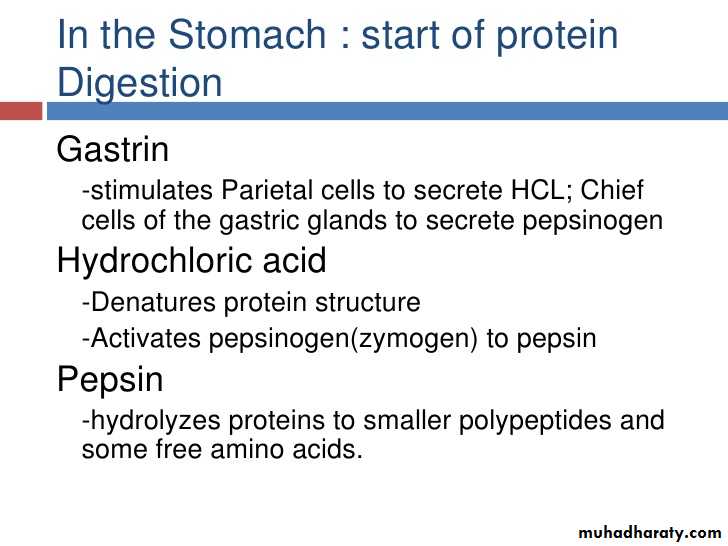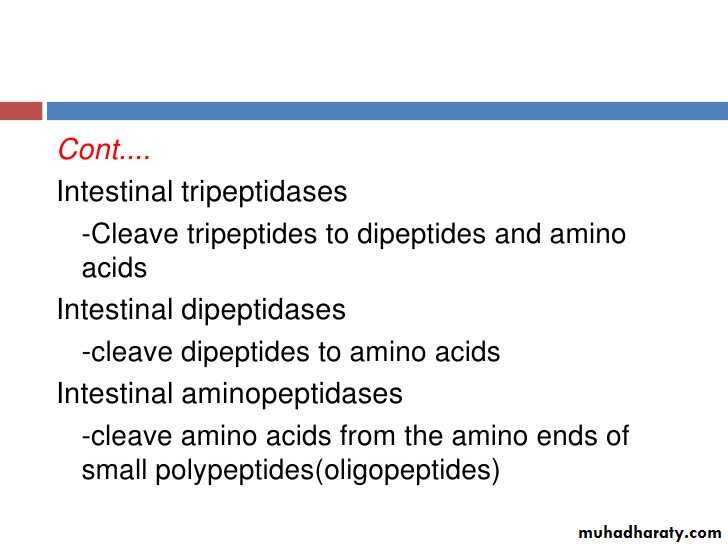Digestion and absorption
Digestion is the breakdown of large insoluble food molecules into small water-soluble food molecules so that they can be absorbed into the watery blood plasma. In certain organisms, these smaller substances are absorbed through the small intestine into the blood stream. Digestion is a form of catabolism that is often divided into two processes based on how food is broken down: mechanical and chemical digestion. The term mechanical digestion refers to the physical breakdown of large pieces of food into smaller pieces which can subsequently be accessed by digestive enzymes. In chemical digestion, enzymes break down food into the small molecules the body can use.Explaination of the processes of digestion and absorption
1- In the mouth, carbohydrates are broken down by amylase into maltose (a disaccharide) and then move down the esophagus, which produces mucus for lubrication, but no digestive enzymes.
2- In the duodenum, disaccharides are broken down into monosaccharides by enzymes called maltases, sucrases, and lactases; the monosaccharides produced are then absorbed into the bloodstream and transported to cells to be used in metabolic pathways to harness energy.
3- In the stomach, proteins are broken down into peptides, which are then broken down into single amino acids that are absorbed in the bloodstream though the small intestine..
4- Lipids are digested mainly in the small intestine by bile salts through the process of emulsification, which allows lipases to divide lipids into fatty acids and monoglycerides.
5- Monoglycerides and fatty acids enter absorptive cells in the small intestine through micelles; they leave micelles and recombine into chylomicrons, which then enter the bloodstream.
6- Fat-soluble vitamins are absorbed in the same manner as lipids; water-soluble vitamins can be directly absorbed into the bloodstream from the intestine.
Chemistry and composition of bile
Bile is a bitter, brownish-yellow or greenish-yellow secretion produced by the liver, stored in the gallbladder, and discharged into the duodenum, where it aids the process of digestion and the absorption of lipids in the small intestine.Summarize the composition and function of bile:
1- Bile is a composition of the following materials: water (85%), bile salts (10%), mucus and pigments (3%), fats (1%), inorganic salts (0.7%), and cholesterol (0.3%).
2- Bile can either drain directly into the duodenum or be temporarily stored in the gallbladder.
3- Bile, which is alkaline, also has the function of neutralizing any excess stomach acid in the small intestine.
Bile acts as a surfactant, helping to emulsify the fats in the food, in the same way that soap emulsifies fat. The bile salts are ionically charged, with a hydrophobic end and a hydrophillic end. When exposed to water mixed with fat, such as in the small intestine, the bile salts congregate around a fat droplet with their hydrophobic side pointing towards the fat and their hydrophillic side pointing towards the water. This increases the surface area of the fat and allows greater access by the pancreatic enzymes that break down fats.
Since bile increases the absorption of fats, it is an important part of the absorption of the fat-soluble vitamins, such as the vitamins D, E, K, and A.
Bile salt action on lipids: nBile salts congregate around fat and separate them into small droplets called micelles.
Besides its digestive function, bile serves also as the route of excretion for bilirubin, a waste byproduct of red blood cells that is recycled by the liver. The alkaline bile also has the function of neutralizing any excess stomach acid before it enters the ileum, the final section of the small intestine. Bile salts also act as bactericides, destroying many of the microbes that may be present in the food.
Composition of Feces
About 75% of fecal weight is made up of water. The other 25% is composed of solid matter which contains:
Undigested fiber and solidified components of digestive juices (30%) 1-
2- Bacteria (30%)
3- Fat (10% to 20%)
4- Inorganic matter (10% to 20%)
5- Protein (2% to 3%)
Carbohydrate digestion and absorption:
Starch, Glycogen and dextrins ( large polysaccharide molecules) ↓α- Amylase
Glucose, Maltose and Maltotriose
(Smaller molecules)
This is incomplete digestion of starch or glycogen in the mouth
2- Digestion in the stomach
There is no enzyme to break the glycosidic bonds in gastric juice. 1-2- However, HCl present in the stomach causes hydrolysis of sucrose
To fructose and glucose.
HCl
Sucrose -----------------˃ Fructose + GlucoseDigestion and absorption of fats Most of the fat in the human diet is in the form of triacylglycerol (TAG), which consists of three fatty acids linked to glycerol. In the digestive tract, TAG is hydrolyzed by the enzyme lipase, to release free fatty acids and monoglycerides.
Emulsification and digestion
The key issue in the digestion and absorption of fats is one of solubility: lipids are hydrophobic, and thus are poorly soluble in the aqueous environment of the digestive tract. The digestive enzyme, lipase, is water soluble and can only work at the surface of fat globules. Digestion is greatly aided by emulsification, the breaking up of fat globules into much smaller emulsion droplets. Bile salts and phospholipids are amphipathic molecules that are present in the bile. Motility in the small intestine breaks fat globules apart into small droplets that are coated with bile salts and phospholipids, preventing the emulsion droplets from re-associating.
The emulsion droplets are where digestion occurs. Emulsification greatly increases the surface area where water-soluble lipase can work to digest TAG. Another factor that helps is colipase, an amphipathic protein that binds and anchors lipase at the surface of the emulsion droplet. Micelles
After digestion, monoglycerides and fatty acids associate with bile salts and phospholipids to form micelles. Micelles are about 200 times smaller than emulsion droplets (4-7nm versus 1µm for emulsion droplets). Micelles are necessary because they transport the poorly soluble monoglycerides and fatty acids to the surface of the enterocyte where they can be absorbed. As well, micelles contain fat soluble vitamins and cholesterol. Micelles are constantly breaking down and re-forming, feeding a small pool of monoglycerides and fatty acids that are in solution. Only freely dissolved monoglycerides and fatty acids can be absorbed, NOT the micelles. Because of their nonpolar nature, monoglycerides and fatty acids can just diffuse across the plasma membrane of the enterocyte. Some absorption may be facilitated by specific transport proteins (for instance see below, for cholesterol).
Chylomicrons
Once inside the enterocyte, monoglycerides and fatty acids are re-synthesized into TAG. The TAG is packaged, along with cholesterol and fat soluble vitamins, into chylomicrons. Chylomicrons are lipoproteins, special particles that are designed for the transport of lipids in the circulation. You can review the structure of lipoproteins by visiting the web page on lipoproteins from fall quarter.
Chylomicrons are released by exocytosis at the basolateral surface of the enterocytes. Because they are particles, they are too large to enter typical capillaries. Instead they enter lacteals, lymphatic capillaries that poke up into the center of each villus. Chylomicrons then flow into the circulation via lymphatic vessels, which drain into the general circulation at the large veins in the chest.
Chylomicrons deliver absorbed TAG to the body's cells. TAG in chylomicrons and other lipoproteins is hydrolyzed by lipoprotein lipase, an enzyme that is found in capillary endothelial cells. Monoglycerides and fatty acids released from digestion of TAG then diffuse into cells.
Cholesterol absorption
Intestinal cholesterol absorption is important because of the clinical relevance of cholesterol: high levels of low-density lipoprotein (LDL) cholesterol in the circulation increase the risk for the development of atherosclerosis. Some of the cholesterol in the small intestine is dietary cholesterol, and some is put there by the liver, arriving via the bile. Of the total cholesterol that passes through the small intestine, only half is typically absorbed, and the rest is eliminated in the feces. Thus, cholesterol in the bile is an example of a substance that is targeted for excretion via the digestive tract. The drug ezetimibe blocks a protein that specifically mediates cholesterol transport across the apical plasma membrane of enterocytes. Ezetimibe has been shown to be effective at reducing levels of LDL cholesterol, particularly when combined with a statin, a drug that inhibits cholesterol synthesis in the liver. The most recent results of a large clinical trial show that further lowering of LDL cholesterol with a combination of ezetimibe and a statin provides a modest benefit in lowering the risk of myocardial infarction and stroke.























